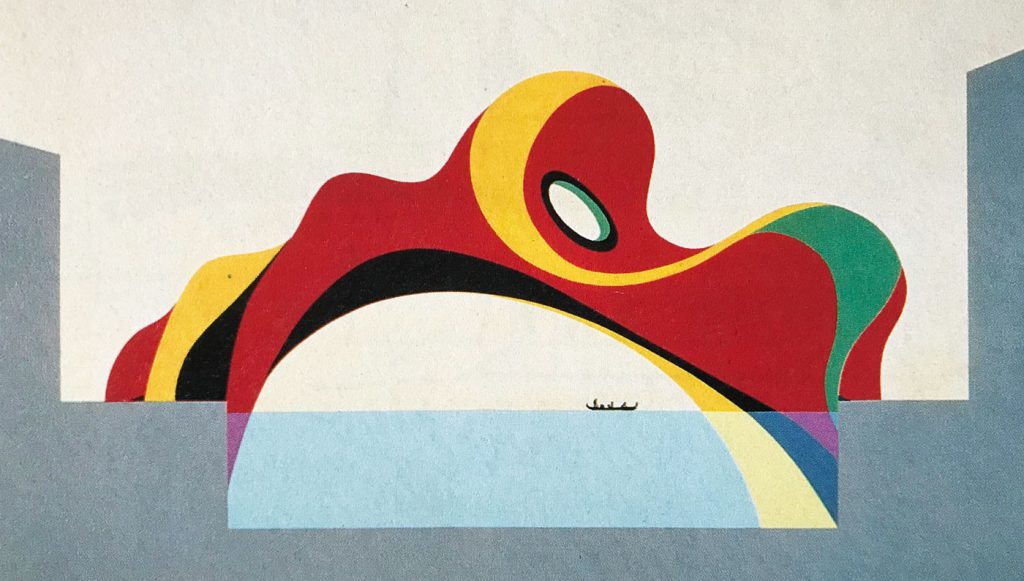
In European living spaces, the classical credenza was an important interior object full of meaning. Depending on the household, it was in the the kitchen or in the dining room, containing objects which could reveal the status, memory and history of a family – plates, cutlery, candlesticks.
I was just accepted as a student in the Master class of Industrial Design at Vienna’s University of Applied Arts. Alessandro Mendini was professor and head of the Master class at the time, and his assignment was to design a sideboard. Not a conventional sideboard, a philosophical sideboard, a credenza filosofica.
For Alessandro Mendini, the thought behind a design was at least as important as the design itself – perhaps more so. His own creations could be so stylized as to appear as fashion statements, and many of them became iconic design classics. His bright colors, bold shapes and patterns even seem to conceal how considered his creations are, highly conceptual with deeply inscribed poetic qualities.
The credenza was the first assignment for me as a fresh design student. Alessandro Mendini designed a range of sideboards himself – the credenza was especially dear to him as it perfectly expressed the history and psychology of a domestic space. Born in 1931, he grew up when Italy was in the grips of Mussolini’s fascist dictatorship in alliance with Hitler’s Nazi Germany. In the 1970’s, Alessandro became one of the figureheads of Italy’s “Radical Design” movement, together with the now legendary studios Archizoom and Superstudio and with personalities such as Ettore Sottsass, Andrea Branzi, Carlo Raggi, Ugo LaPietra and Riccardo Dalisi.
The longer I worked on the credenza filosofica, the more it became a symbolic storage for history, a shrine for a time which was lost, an object to enable memories, a conduit for hope. Through Alessandro’s assignment and guidance, I learned that design is a never-ending process of investigation, experimentation and expression. When you manage to transcend boundaries, your design has achieved a purpose.

Alessandro Mendini was always far ahead of his time. He was the main design advisor of Alessi, working with designers such as Achille Castiglioni, Aldo Rossi, Richard Sapper and Philippe Starck. He was chief editor of the influential Casabella and Domus magazines, where he wrote on design and architecture theory and at the same time directed scenographic cover designs. He created the first experiential performances in design: “Blazing Chair” for Zanotta and “Blackout” for the Triennale di Milano. With his series “Irony for great work” he single-handedly invented redesign and made it into a programmatic approach.
For Alessandro, design, if it was just about aesthetics and functionality, was hopelessly simplified. Design was about much more than that: it had to function in a truly holistic way. It is only now that the design community comes to realize some aspects Alessandro pointed out in the 1970’s and 80’s through his designs, his leadership of the design group Alchimia and his writing for Casabella, Domus and Modo: that semantic, cultural, and philosophical aspects are at least as important as the look and the functioning of things. With Alessandro, design had ethos, was often experimental, had a revolutionary streak and always a bright, optimistic touch. It was nothing less than applied humanism.
In September 2018, I contacted Alessandro again. He was wonderful and kind as always, but I could not meet him in person, as he was already in intensive care. He passed away February 18, 2019.
Unfortunately, I never built the credenza filosofica. It remained a scale model which, through the ups and downs of life, fell into pieces and got lost. But it still exists vividly in my mind, and there it now holds the loving memory of my philosophical mentor and first teacher, the best teacher anyone could ever have had: Alessandro Mendini.
– Mario Gagliardi, 2019
“Even if you’ve never heard of Alessandro Mendini, you’re bound to have been affected by his work. That’s because our lives would be different without him.”
– Alice Rawsthorn – Director, London Design Museum
“Alessandro Mendini is one of the rare, most iconic architects and architectural minds in the history of art and architecture and clearly within the profound ranks of Leonardo Da Vinci, Palladio, Alberti, and Ledoux. His philosophic thinking is more than original. He has pushed concept beyond the perimeters of the inventive, relentlessly searching, in a most non-compromising way, for the most essential design idea. And the results center on the most visionary and far-reaching of our times. In an era where architectural ideas are copied and duplicated worldwide faster than ‘viral’, Mendini and his works remain singular, prophetic, and original with the unique finger print of nothing less than a genius architect.”
– Christian Narkiewicz-Laine – Museum President of the Chicago Athenaeum